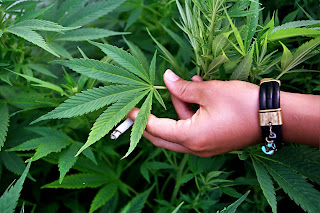
In what many film critics exalted was the best film of 2000, “Traffic” is a cinematically dazzling film that takes a look at the U.S. government’s war on drugs, from a realistic and gritty perspective.
Director Steven Soderbergh (“Erin Brockovich,” “Ocean’s Eleven”) takes a revealing approach by illustrating the world of drugs through the human experiences of different characters.
Javier Rodriguez (Benicio Del Toro) is a Mexican policeman constantly contemplating whether or not to become part of the well-known corruption that surrounds him. Del Toro's character is pivotal to the film because he accurately portrays life along the Mexico border.
Robert Wakefield (Michael Douglas) is the newly appointed drug czar for the United States, and he is told specifically to make a difference.
Soderbergh does an exceptional job of telling a controversial story, and surprisingly does not allow the film to become a lecture on drug use.
Director Steven Soderbergh (“Erin Brockovich,” “Ocean’s Eleven”) takes a revealing approach by illustrating the world of drugs through the human experiences of different characters.
Javier Rodriguez (Benicio Del Toro) is a Mexican policeman constantly contemplating whether or not to become part of the well-known corruption that surrounds him. Del Toro's character is pivotal to the film because he accurately portrays life along the Mexico border.
For example, there is a scene where Del Toro is eating and carefully pours some authentic Mexican salsa on his tacos. The salsa does not come from a packet that is available in most Mexican fast food restaurants. Del Toro's home is also inconveniently small, illustrating the frustration and struggle of living in Mexico.
The overall appearance of Del Toro's character makes him undeniably believable. He wears jeans, cowboy boots, and sunglasses, portraying a man who works in Mexico, but has clearly clearly been exposed to American culture.
The overall appearance of Del Toro's character makes him undeniably believable. He wears jeans, cowboy boots, and sunglasses, portraying a man who works in Mexico, but has clearly clearly been exposed to American culture.
In other words, Del Toro is gradually leaving behind his Mexican roots because of his involvement with the American government.
Ray Castro (Luis Guzmán) and Montel Gordon (Don Cheadle) are two DEA agents trying desperately to make a middle-man drug dealer give up information regarding his cartel boss. They make a great team because they show the complexities of actually getting a well-known criminal convicted.
Ray Castro (Luis Guzmán) and Montel Gordon (Don Cheadle) are two DEA agents trying desperately to make a middle-man drug dealer give up information regarding his cartel boss. They make a great team because they show the complexities of actually getting a well-known criminal convicted.

Robert Wakefield (Michael Douglas) is the newly appointed drug czar for the United States, and he is told specifically to make a difference.
At the beginning of the film, Douglas’ self-confidence is soaring, but as he familiarizes himself with the important elements of the drug trade, he realizes he has bitten off more than he can chew.
Seth Abrahms (Topher Grace), a high school student, reveals the complexity of the drug trade by explaining how narcotics continue to flourish in African-American communities.
Seth Abrahms (Topher Grace), a high school student, reveals the complexity of the drug trade by explaining how narcotics continue to flourish in African-American communities.
Soderbergh does an exceptional job of telling a controversial story, and surprisingly does not allow the film to become a lecture on drug use.
The film is not afraid to show uncomfortable or graphic scenes, which gives the story more credibility. Soderbergh filmed nearly every scene with a hand-held camera, according to the Internet Movie Database, giving each location a personal and intimate feel.
With the heavy yellow look, Traffic makes the border appear much larger, and gives an overwhelming feeling of uncertainty. The border is completely unpredictable and I think this film does a successful job in illustrating a place so close, yet so far.
Traffic was groundbreaking for all filmmakers, because it discusses a controversial issue the entire world is familiar with. The film is important because it provides a realistic interpretation of what the drug world is all about: corruption.
With drug trafficking remaining a frequent and dangerous problem along the border, it became a central plot element in the film.
Traffic was groundbreaking for all filmmakers, because it discusses a controversial issue the entire world is familiar with. The film is important because it provides a realistic interpretation of what the drug world is all about: corruption.
With drug trafficking remaining a frequent and dangerous problem along the border, it became a central plot element in the film.
There is a scene where Michael Douglas is inspecting a sedan for narcotics, and Border Patrol agents reveal to him the unique spots in automobiles where drugs are hidden the most frequently. Douglas appears shocked and bewildered when he realizes people will stop at nothing to transport illegal drugs.
 This movie will remain groundbreaking because it took a risk and shed light on a dark subject: drug trafficking and the U.S./Mexico Border.
This movie will remain groundbreaking because it took a risk and shed light on a dark subject: drug trafficking and the U.S./Mexico Border.
 This movie will remain groundbreaking because it took a risk and shed light on a dark subject: drug trafficking and the U.S./Mexico Border.
This movie will remain groundbreaking because it took a risk and shed light on a dark subject: drug trafficking and the U.S./Mexico Border. It is well-known the border has been plagued by continual drug smuggling, but if we are to make any progress concerning immigration reform, we must begin with educating the students in our communities.
Traffic is a dark film with graphic drug use, but it has enough substance and intellectual content to be used as a tool for learning.
Sources:







 Border Patrol is responsible for ultimately keeping the border safe, but they have also been the center of illegal activity.
Border Patrol is responsible for ultimately keeping the border safe, but they have also been the center of illegal activity.










 Even though authorities have heavily cracked down on drug trafficking along the border, Mexican drug gangs have still remained prevalent and an ongoing problem for federal troops. It is extremely difficult to eliminate all of the gangs in some areas, because drug dealers have gradually replaced local government authority.
Even though authorities have heavily cracked down on drug trafficking along the border, Mexican drug gangs have still remained prevalent and an ongoing problem for federal troops. It is extremely difficult to eliminate all of the gangs in some areas, because drug dealers have gradually replaced local government authority.





